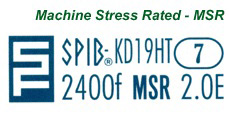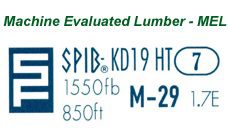Grading Methods
Southern Pine
Lumber Grading Methods
Southern Pine lumber grading is more than just visually inspecting wood for knots. Training graders is a rigorous, time-consuming process, as they must consider many characteristics to assure the lumber meets American Lumber Standard Committee (ALSC) standards and buyers receive the proper grade. The task of grading requires training, supervision, experience, and control and auditing systems that take years to understand and master.
Simply put, do not assume you can simply read grade rules and apply them or grade lumber yourself.
With that said, there are three Southern Pine lumber grading methods for sorting dimension lumber and assigning design values:
Visually Graded Lumber
 This is the oldest and most common of the three methods where qualified graders perform visual grading in the mill. These graders sort each piece of lumber into various grades based on visual characteristics known to affect lumber strength and stiffness, such as knot size and slope-of-grain.
This is the oldest and most common of the three methods where qualified graders perform visual grading in the mill. These graders sort each piece of lumber into various grades based on visual characteristics known to affect lumber strength and stiffness, such as knot size and slope-of-grain.
Consistent visual grading is achieved through proper training, education, and supervision of lumber graders. Visually graded lumber will adequately meet the structural requirements for most traditional applications.
Machine Graded
Grade marks for Machine Stress Rated (MSR) lumber and Machine Evaluated Lumber (MEL can include “1W” or “2W” if visually graded to the wane restrictions for No. 1 or No.2 visual grades, respectively. While each machine grading technique reduces the variability associated with assigning stress grades to lumber, there are slight differences between the two:
- Machine Stress Rated lumber is evaluated by mechanical stress rating equipment. MSR lumber is distinguished from visually graded lumber in that each piece is nondestructively tested and then sorted into bending strength and stiffness classes. Each piece of MSR lumber also must meet certain visual requirements before it can be assigned design values, which requires daily quality control tests for bending strength and stiffness.

- Machine Evaluated Lumber is similar to MSR in that each piece is evaluated by nondestructive grading equipment, checked for visual requirements and then sorted into various strength classifications. MEL requires daily quality control tests for tension strength in addition to the daily bending strength and stiffness tests required for MSR.1W_mark_230x100.

Availability
 The Standard Grading Rules for Southern Pine Lumber provide for numerous visual, MSR, and MEL grades. However, not all of those possible grade/size combinations are produced or used in the marketplace.
The Standard Grading Rules for Southern Pine Lumber provide for numerous visual, MSR, and MEL grades. However, not all of those possible grade/size combinations are produced or used in the marketplace.
Available grades and sizes are subject to change, so check your supply sources at the time of your project.